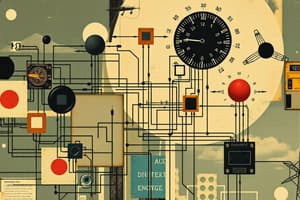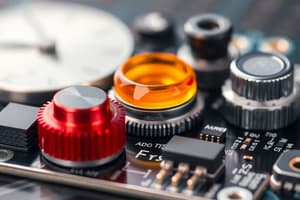Podcast
Questions and Answers
What is the primary function of sensors in an IoT system?
What is the primary function of sensors in an IoT system?
The primary function of sensors in an IoT system is to collect real-time data from their surroundings.
Why is having a unique IP address important for devices in an IoT system?
Why is having a unique IP address important for devices in an IoT system?
A unique IP address is important as it allows devices to be easily identifiable over a large network.
What role do processors play in an IoT system?
What role do processors play in an IoT system?
Processors serve as the brain of the IoT system, processing data captured by sensors and extracting valuable information.
How do gateways contribute to the functionality of an IoT system?
How do gateways contribute to the functionality of an IoT system?
What are applications used for in the context of IoT?
What are applications used for in the context of IoT?
What is meant by 'autonomous' and 'user-controlled' in relation to IoT devices?
What is meant by 'autonomous' and 'user-controlled' in relation to IoT devices?
Why is user perspective important when designing IoT-enabled products?
Why is user perspective important when designing IoT-enabled products?
Can you name some examples of sensors used in IoT systems?
Can you name some examples of sensors used in IoT systems?
Why is prototyping critical in the early stages of IoT projects?
Why is prototyping critical in the early stages of IoT projects?
What challenges do users face when upgrading IoT devices?
What challenges do users face when upgrading IoT devices?
What role do alliances play in the IoT ecosystem?
What role do alliances play in the IoT ecosystem?
Identify two organizations involved in international IoT standards development.
Identify two organizations involved in international IoT standards development.
What defines a basic IoT device?
What defines a basic IoT device?
List two key properties of IoT devices.
List two key properties of IoT devices.
What types of communication can IoT devices utilize?
What types of communication can IoT devices utilize?
What is IoT architecture?
What is IoT architecture?
What is the significance of device management in IoT?
What is the significance of device management in IoT?
What are the two primary classifications of IoT architecture?
What are the two primary classifications of IoT architecture?
What components are included in the four-layered architecture of IoT?
What components are included in the four-layered architecture of IoT?
Describe the function of the sensor/perception layer in IoT architecture.
Describe the function of the sensor/perception layer in IoT architecture.
What role does the network layer play in IoT architecture?
What role does the network layer play in IoT architecture?
What is the purpose of the middleware layer in IoT architecture?
What is the purpose of the middleware layer in IoT architecture?
Explain the function of the application layer in IoT architecture.
Explain the function of the application layer in IoT architecture.
What does the business layer in IoT architecture determine?
What does the business layer in IoT architecture determine?
What is the first stage in managing M2M data?
What is the first stage in managing M2M data?
How does data acquisition function in the context of M2M interactions?
How does data acquisition function in the context of M2M interactions?
What is the purpose of data validation in M2M data management?
What is the purpose of data validation in M2M data management?
What is meant by 'Big Data' in the context of M2M interactions?
What is meant by 'Big Data' in the context of M2M interactions?
What is the objective of data processing in M2M data management?
What is the objective of data processing in M2M data management?
What does data remanence refer to in M2M data management?
What does data remanence refer to in M2M data management?
What techniques are used to handle data remanence?
What techniques are used to handle data remanence?
Why is data analysis important in the management of M2M data?
Why is data analysis important in the management of M2M data?
What is one major challenge faced by enterprise systems in processing IoT data?
What is one major challenge faced by enterprise systems in processing IoT data?
How can the intelligence and computation in IoT be effectively managed?
How can the intelligence and computation in IoT be effectively managed?
What does the term 'Everything-as-a-Service' (XaaS) signify?
What does the term 'Everything-as-a-Service' (XaaS) signify?
Give an example of offerings that have emerged under the XaaS model apart from SaaS, PaaS, and IaaS.
Give an example of offerings that have emerged under the XaaS model apart from SaaS, PaaS, and IaaS.
What is a practical benefit of minimizing communication with enterprise systems in IoT?
What is a practical benefit of minimizing communication with enterprise systems in IoT?
How has the concept of XaaS changed traditional service delivery?
How has the concept of XaaS changed traditional service delivery?
Why is the trend towards distributed business processes in IoT important?
Why is the trend towards distributed business processes in IoT important?
What role does increased computational resources on devices play in IoT?
What role does increased computational resources on devices play in IoT?
What mechanism allows consumers to access computing capabilities without requiring human interaction?
What mechanism allows consumers to access computing capabilities without requiring human interaction?
How do service providers ensure resource availability in a cloud computing environment?
How do service providers ensure resource availability in a cloud computing environment?
What is meant by 'rapid elasticity' in cloud computing?
What is meant by 'rapid elasticity' in cloud computing?
What are some resources that can be monitored and reported in a cloud service?
What are some resources that can be monitored and reported in a cloud service?
In which cloud service model do end-users typically not manage the underlying infrastructure?
In which cloud service model do end-users typically not manage the underlying infrastructure?
What is a significant characteristic of cloud computing concerning location control?
What is a significant characteristic of cloud computing concerning location control?
Why is the capability of 'measured service' important in cloud computing?
Why is the capability of 'measured service' important in cloud computing?
What types of devices can access cloud services due to broad network access?
What types of devices can access cloud services due to broad network access?
Flashcards
What is IoT Architecture?
What is IoT Architecture?
Refers to the interconnected components like sensors, actuators, cloud services, protocols, and layers that make up IoT systems.
Why is IoT Architecture layered?
Why is IoT Architecture layered?
A framework that divides IoT systems into layers, helping to manage, monitor, and ensure system stability.
How does data flow in IoT architecture?
How does data flow in IoT architecture?
It involves the flow of data from sensors or devices to the cloud, where it gets processed, analyzed, and stored.
What is the perception layer in IoT architecture?
What is the perception layer in IoT architecture?
Signup and view all the flashcards
What is the network layer in IoT architecture?
What is the network layer in IoT architecture?
Signup and view all the flashcards
What is the middleware layer in IoT architecture?
What is the middleware layer in IoT architecture?
Signup and view all the flashcards
What is the application layer in IoT architecture?
What is the application layer in IoT architecture?
Signup and view all the flashcards
What is the business layer in IoT architecture?
What is the business layer in IoT architecture?
Signup and view all the flashcards
Rapid Prototyping in IoT
Rapid Prototyping in IoT
Signup and view all the flashcards
What is an IoT Device?
What is an IoT Device?
Signup and view all the flashcards
What are Basic IoT Devices?
What are Basic IoT Devices?
Signup and view all the flashcards
What is an Execution Environment (EE) in IoT?
What is an Execution Environment (EE) in IoT?
Signup and view all the flashcards
What are Standards in IoT?
What are Standards in IoT?
Signup and view all the flashcards
Why are IoT Alliances Formed?
Why are IoT Alliances Formed?
Signup and view all the flashcards
Interoperability in IoT
Interoperability in IoT
Signup and view all the flashcards
What is Device Management (DM) in IoT?
What is Device Management (DM) in IoT?
Signup and view all the flashcards
IoT Devices
IoT Devices
Signup and view all the flashcards
Processors in IoT
Processors in IoT
Signup and view all the flashcards
IoT Gateways
IoT Gateways
Signup and view all the flashcards
IoT Applications
IoT Applications
Signup and view all the flashcards
Understanding User Needs
Understanding User Needs
Signup and view all the flashcards
Security in IoT
Security in IoT
Signup and view all the flashcards
User-Centered Design
User-Centered Design
Signup and view all the flashcards
Sustainable IoT Design
Sustainable IoT Design
Signup and view all the flashcards
Data Generation
Data Generation
Signup and view all the flashcards
Data Acquisition
Data Acquisition
Signup and view all the flashcards
Data Validation
Data Validation
Signup and view all the flashcards
Data Storage
Data Storage
Signup and view all the flashcards
Data Processing
Data Processing
Signup and view all the flashcards
Data Remanence
Data Remanence
Signup and view all the flashcards
Data Analysis
Data Analysis
Signup and view all the flashcards
Everything-as-a-Service (XaaS)
Everything-as-a-Service (XaaS)
Signup and view all the flashcards
Distributed Business Processes in IoT
Distributed Business Processes in IoT
Signup and view all the flashcards
Minimizing Communication in IoT
Minimizing Communication in IoT
Signup and view all the flashcards
Distributed Intelligence in IoT
Distributed Intelligence in IoT
Signup and view all the flashcards
Traditional Approach to IoT Data Processing
Traditional Approach to IoT Data Processing
Signup and view all the flashcards
Enterprise Systems Processing All IoT Data
Enterprise Systems Processing All IoT Data
Signup and view all the flashcards
Enhanced Device Capabilities in IoT
Enhanced Device Capabilities in IoT
Signup and view all the flashcards
Evolution of Intelligence in IoT
Evolution of Intelligence in IoT
Signup and view all the flashcards
Rapid elasticity in cloud computing
Rapid elasticity in cloud computing
Signup and view all the flashcards
Resource pooling in cloud computing
Resource pooling in cloud computing
Signup and view all the flashcards
Broad network access in cloud computing
Broad network access in cloud computing
Signup and view all the flashcards
Location independence in cloud computing
Location independence in cloud computing
Signup and view all the flashcards
Software as a Service (SaaS)
Software as a Service (SaaS)
Signup and view all the flashcards
Measured Service in cloud computing
Measured Service in cloud computing
Signup and view all the flashcards
Cloud Deployment Options
Cloud Deployment Options
Signup and view all the flashcards
SaaS Service Model
SaaS Service Model
Signup and view all the flashcards
Study Notes
IoT Architectural Overview
- IoT architecture encompasses interconnected components like sensors, actuators, cloud services, protocols, and layers.
- It's layered to facilitate administrators evaluating, monitoring, and maintaining system integrity.
- The IoT architecture is a four-step process: data flows from sensors to a network and then to the cloud for processing, analysis, and storage.
Four- and Five-Layered Architectures
- Four-layered: Consists of media/device, network, service/application support, and application layers.
- Five-layered: Includes perception, network, middleware, application, and business layers.
Functions of Each Layer
- Sensor/Perception Layer: This layer encompasses wireless devices, sensors, and RFID tags that collect and transfer data (temperature, moisture, etc.).
- Network Layer: This layer is responsible for data routing to the next layer using wired/wireless technologies.
- Middleware Layer: With databases to store information received from lower layers, it performs processing and uses the results for further decisions.
- Service and Application Support Layer: Involves business process modeling, execution, IoT service monitoring, and resolution.
- Application Layer: Consists of interfaces for applications like home automation, electronic health monitoring.
- Business Layer: Determines future actions based on the data from lower layers.
4-Stage IoT Architecture
- A hierarchical representation of the IoT layers, displaying data flow and control flow.
- Top layers, including Application and Data Processing, are positioned for processing and management.
- The bottom layer, Sensing, consists of physical objects, sensors, and actuators.
IoT Architecture (Perception/Sensing Layer)
- The first layer of any IoT system comprises "things" or endpoint devices that connect the physical and digital worlds.
- Sensors and actuators gather, process, and transmit data wirelessly or through wires.
IoT Architecture (Network Layer)
- This layer outlines data movement throughout the application.
- It includes data acquisition systems (DAS) and internet gateways, responsible for aggregating and converting data (e.g., from analog to digital).
- It facilitates connections between sensor devices, servers, and smart devices.
IoT Architecture (Processing Layer)
- The processing layer acts as the brain of the IoT system by analyzing, pre-processing, and storing data before relaying to the data center.
- This manages and monitors data.
IoT Architecture (Application Layer)
- Application layer is the user interaction layer of the IoT ecosystem.
- User interface and application services for users.
- Examples include smart home automation, monitoring, etc.
Building Blocks of IoT
- Sensors: The front-end devices collecting data from surroundings or transmitting data (actuators). They must be uniquely identifiable.
- Processors: Extract meaningful data from massive raw data, performing intelligence processing.
- Gateways: Route processed data to appropriate locations, facilitating data communication. Examples include LAN, WAN, and PAN.
- Applications: Facilitate data usage and provide services (e.g. home automation, security systems).
M2M and IoT Technology Fundamentals- Devices and Gateways
- A device is a hardware unit sensing environment and performing tasks within it.
- Microcontroller is the basic processing unit, and other components include power source (fixed, battery, etc.), communication (cellular, wireless), Operating System (OS), applications, user interface, device management, and execution environment.
Device Types
- Basic Devices: Collect sensory data and optionally interact with users, often reliant on wired/wireless LAN communication and require a gateway for WAN access.
- Advanced Devices: Handle application logic and WAN connections. Often host applications enabling multiple applications and device management.
Deployment Scenarios for Devices
- Home Alarms: Typical devices in a home automation system
- Smart Meters: Monitor and aggregate resource usage.
- Advanced Devices examples: Onboard units in vehicles, autonomous robots, video cameras, and monitoring of remote devices.
Gateways
- Translate between different protocols (e.g., IEEE 802, 15.4/802.11 to Ethernet/cellular).
- Often work at physical and link layer, but also handles application layer translation.
- Examples: ZigBee gateways, translating from ZigBee to SOAP and IP.
- Common data management functions for gateways include data management, sensor readings, and data caching and filtering.
M2M Communication
- Allows communication between devices of the same type for specific applications.
- M2M is used for asset tracking, remote monitoring, etc., and doesn't typically involve communication directly to the internet.
- A typical M2M system integrates M2M devices, communication networks, service enabling, and application logic.
Managing M2M Data
- Data Generation: Data generation encompasses the active or passive creation of data by interactions among devices.
- Data Acquisition: The process of collecting M2M data.
- Data Validation: Checking the accuracy and meaningfulness of acquired data.
- Data Storage: Storing acquired data for future processing.
- Data Processing: Data processing transforms raw data and provides calculated values.
- Data Remanence: Residual data traces even after deletion or removal.
- Data Analysis: Analysis of captured data.
IoT
- IoT is a collective term for technologies, systems, and designs related to internet-connected devices within the physical environment.
- IoT differs from M2M in that IoT extends to broader internet communication.
- It encompasses various applications (e.g., smart cities, agriculture, health).
LAN and WAN
- LANS (Local Area Networks): Networks within a limited geographical area (e.g., house, building). LANs facilitate data sharing and resource (printers, etc.) access.
- WANs (Wide Area Networks): networks spanning large geographic distances (e.g., countries). WANs use high-end telecommunication lines for connectivity and are generally more expensive and complex to set up and manage.
Business Processes in IoT
- Business processes encompass related activities within an enterprise aiming for specific outcomes (management, operational, support).
- Business processes in the IoT are transforming through real-time data, leading to automated decision-making.
Everything-as-a-Service (XaaS)
- A service-delivery model where virtualized services and applications are accessed and used remotely via the internet.
- This offers flexibility to scale up or down as required.
- Examples include Hardware-as-a-Service (HaaS), Communication-as-a-Service (CaaS), Desktop-as-a-Service (DaaS), Healthcare-as-a-Service (HaaS), and Transportation-as-a-Service (TaaS).
Cloud Computing Characteristics
- On-Demand Self-Service: Customers can provision computing resources on their own.
- Broad Network Access: Resources are accessible through network-connected devices.
- Resource Pooling: Provider resources are pooled, with allocation based on consumer needs.
- Rapid Elasticity: Resources can be scaled up or down quickly.
- Measured Service: The provider's resource use is measured, allowing billing based on consumption.
Deployment Models
- Private Cloud: cloud infrastructure for exclusive use by a single organization.
- Community Cloud: cloud infrastructure shared by a specific community of consumers with shared concerns.
- Public Cloud: cloud infrastructure shared with the general public.
- Hybrid Cloud: composition of two or more distinct cloud infrastructure types (private, community, or public) that remain as separate entities.
Distributed Business Processes in IoT
- To effectively handle the vast scale and data volume of IoT, processes need distribution onto the network and device layers.
- Focus is on minimizing communication between enterprise systems and distributing the required intelligence and computation to the edge devices.
Studying That Suits You
Use AI to generate personalized quizzes and flashcards to suit your learning preferences.





